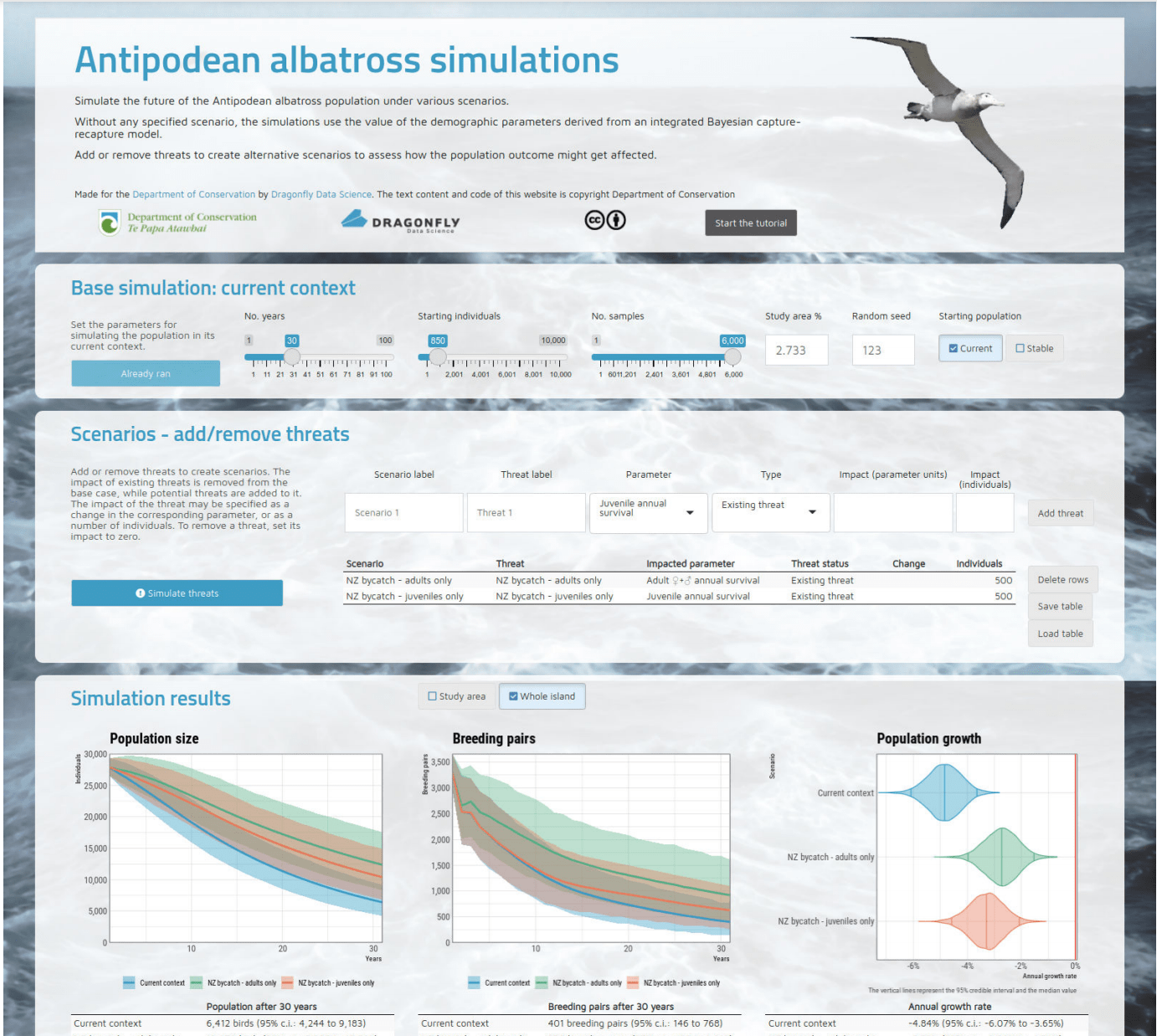Action to halt the estimated annual 5 percent decline of the Antipodean albatross population is essential. The integrated population model and app we created allow stakeholders to explore the effects of different threats and management strategies. This is intended to help guide decisions to secure the future of the species.
Albatross flying into trouble
Antipodean albatross fly across the world but only breed on the isolated Antipodes Island, 750 km southeast of New Zealand. Their population has declined by two thirds in the last 15 years from about 16,000 to 6,000 breeding birds. Each season birds leave the island but some, especially females, fail to return.
The major threat to the population is thought to be accidental capture by longline fishing vessels outside New Zealand waters. Bycatch within New Zealand waters and climate change are additional threats.
A simulation tool to guide decision-making
DOC is responsible for the conservation of New Zealand’s native species. It needed to understand the future trajectory of the Antipodean albatross population, as well as the effect of different measures that could be taken to reverse the decline.
Being able to model the effects of different management strategies (like reducing bycatch) was seen as a powerful tool to include stakeholders in the decision-making process.

Developing an integrated population model
The model uses Bayesian statistics to estimate the main demographic parameters that are driving the population dynamics. It takes into account the detectability of individual birds, annual variations of survival rates and breeding success, and movements in and out of the study area.
The software Stan was used to fit the model and produce the parameters and the associated uncertainty. The parameters were then used to simulate the fate of the population. The model indicates with reasonable confidence that the population is declining at about 5 percent per year.
Good data collection and preparation
Data for the model was collected by DOC scientists Kath Walker and Graeme Elliott. They have ensured Antipodes Island was visited for 4–6 weeks almost every summer for the last 27 years. This modelling work would not have been possible without their dedication and support.
For the first few years, Kath and Graeme counted nests on the whole island. After this, they focussed most of their work on birds in one more accessible corner of the island to increase the accuracy of the data. They noted when banded birds left, returned, bred or disappeared using capture-recapture methods. This data was then extrapolated within the integrated population model to represent the whole population.
Kath and Graeme were involved throughout this project, especially in the start-up phase when the data was being prepared. The final population model mirrors the serious decline they have seen in the number of birds since 2006.
Simulation tool is online and easy to use
DOC chose to make the tool open access using a Shiny app so people can see what needs to happen to stabilise the population and prevent further decline. Changing parameters in the app allows people to see for themselves what is needed – and what happens if the death of 100 birds can be prevented, for example.
The accessibility of the app also supports transparency and agreement between stakeholders about which actions should be prioritised.
Complexity and uncertainty
Unlike models where data for a whole population is available, this model is based on data from a portion of the total albatross population. This adds uncertainty because if a bird is not seen one year, it may be dead or simply living in another part of the colony. (Fortunately this is rare because these albatross have strong nest-site fidelity.) Statistical methods were used to separate these possibilities.
The model also takes account of the life stages of the birds, from chick to juvenile, pre-breeder and adult and the different demographic parameters for each stage.
Model indicates further population decline
This model confirms previous work, but is much more robust. Despite being able to account for the possibility that missing birds are living elsewhere, the population trajectory for the birds remains dire.
The results also indicate that many threats are working together to cause the serious population decline. This suggests that a more holistic approach to conservation at sea is required to safeguard the future of the species.
Project team
Yvan Richard, Laura Tremblay-Boyer
More information
I can’t think of a more difficult species to model than albatross. They breed every second year, the chick goes to sea for 3–8 years, they start breeding at different ages and their probability of survival increases as they get older. It’s very complex to put that together, but this model fuses all the data in a really neat way.
There have been previous modelling attempts but this is a step up for sure. Models are never perfect, but we’re very happy with this work – that’s why it got put on the Minister’s desk.
Dr Johannes Fischer
Technical Advisor Marine
Department of Conservation | Te Papa Atawhai .

